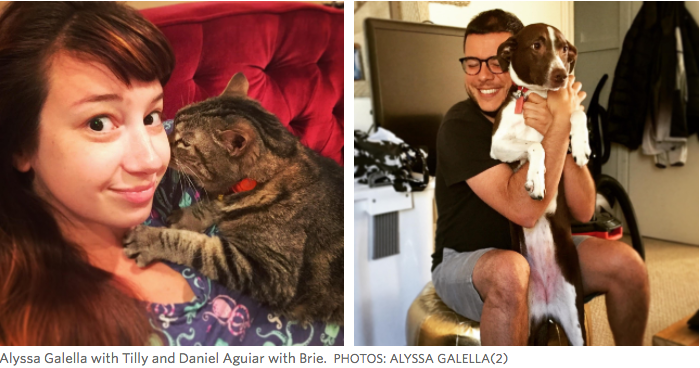By HILARY POTKEWITZ
Amanda Brazeau and Scott McLeish started dating in 2015 and often planned activities they could do with their canine companions, like walks to the park and pet sleepovers at their Ottawa homes.
Her dog Lola, a bulldog-pug mix, tended to be aggressive toward other dogs, while Mr. McLeish’s dog Cato, a German shorthaired pointer, always wanted to play. “He’s like the fun, drunk guy at a party who doesn’t know he’s being annoying,” she says.
Ms. Brazeau, 33 years old, and Lola, 7, moved in with Mr. McLeish, 34, and Cato, 9, last year. “And then the fights started,” she says. Lola was usually the aggressor, but, as the smaller dog, would often end up hurt.
Ms. Brazeau also brought two house cats. Cato had no experience with felines, but as a hunting dog, he had to chase. “Then Lola’s pack instinct would kick in, and they’d both be chasing,” she says. “We had to set up blockades around the house. It was a horrible time.”
Many young urban professionals are getting married later, and pet ownership in that group is rising. So when animal-lovers couple up, it is often with someone who is already in a committed relationship–with their pet.
That makes moving in together a lot more complicated.
Some couples get lucky and their animals adapt into a happy family. But often, newly blended households devolve into turf wars and crime scenes, where each day has the potential to end with someone peeing on the couch. In the worst cases, pet owners move in together and find their animals fight tooth and claw.
“Conflict travels right up the leash,” says Philadelphia dog trainer Nicole Larocco-Skeehan. Animal spats often lead to human arguments, she says. “I’ve seen more relationships dissolve because the dogs aren’t getting along than I’ve seen people willing to re-home their dogs.”
Ms. Brazeau says she and Mr. McLeish started arguing about dog trainers and discipline methods. Giving up an animal wasn’t an option, she says.
They hired Jessica O’Neill, a local canine behaviorist, to help with the chaos.
“When every foundation of a dog’s life is disrupted, it’s really difficult for them,” Ms. O’Neill says. That includes how they get food, where they sleep, and where they’re put when left home alone. On top of all that, there is a new rival for human affection.
The first order of business, Ms. O’Neill says, is to replicate old routines.
“If your dog is used to eating by himself in a room, you can’t say, ‘Here’s your new brother. Here are your bowls. You two will eat side by side from now on.’ ” For cats, each feline needs its own litter box on each floor of the house.
Other practices include designating a confined space for each animal, giving them 15 minutes alone several times a day, and leash exercises to build trust.
After a few months of daily drills, Ms. Brazeau says the dogs settled into a fragile truce. She and Mr. McLeish plan to get married in October.
Alyssa Galella and Daniel Aguiar, both 31, moved in together in March after getting engaged. Ms. Galella and Tilly, her rescue cat, relocated to the West Los Angeles two-bedroom condominium that Mr. Aguiar shared with Brie, his 6-year-old Australian shepherd mix. Each animal has its own Instagram account: @tillygato and @hipsterbrie.
They knew the transition would be tough, because “Tilly doesn’t like anyone who isn’t me,” Ms. Galella says. Brie was fascinated, always trying to sniff or lick the cat. “Tilly would hiss and swat, and she has all her claws,” Ms. Galella says.
Fearing for the dog’s safety, they surrendered the spare bedroom to the cat, installing a special gate that lets her come and go without Brie getting in. Tilly’s room is outfitted with a giant kitty castle, among other feline amenities.
The altercations have stopped, though the animals are never together unsupervised. Brie will stick her head in the cat gate and whine if the humans spend time in Tilly’s room.
The couple have had only one overnight guest so far, “And she was very quiet and calm and gentle, and I don’t think Tilly minded having her stay,” Ms. Galella says. “I don’t know how she would feel about other guests.”
Some pet feuds have no good resolution, leading couples to take desperate measures. Tina Willis, 47, and John Schutz, 55, have found themselves stuck between feuding cats since they married 12 years ago in Orlando, Fla. From the get-go, her tomcat Razzle hated his feline Pixey, stalking and attacking her all over the house. Razzle also started spraying whenever Pixey was nearby.
They tried several veterinary solutions, including Prozac, but drugs made Razzle catatonic. “It took away his personality. Even though he’s mean to this one cat, he’s super affectionate with us,” Ms. Willis says.
They eventually moved Pixey into the garage, where she has been living in isolation. “It’s really sad,” Ms. Willis says. They installed window perches and other cat paraphernalia and try to nuzzle Pixey every time they walk through the garage.
Mr. Schutz recently started smuggling Pixey into his home office in the evenings, moving her back into the garage at sunrise to avoid riling Razzle. But the tomcat stills sprays when he figures it out, Ms. Willis says.
“It’s mortifying. We’ve been holding back on buying nice furniture. We have slipcovers on everything,” she says. “But what are we going to do, get rid of a cat that’s part of our family?”
Cats and dogs hold no monopoly on human heartstrings. Other animals can form intense attachments with their owners and may act out when they sense a rival, says Dr. Meera Music, associate veterinarian at the Center for Bird & Exotic Animal Medicine, north of Seattle.
“I just saw clients where the husband’s African gray parrot is in love with him and hates his wife, and the wife’s macaw is in love with her and hates the husband,” Dr. Music, 32, says.
When agitated or jealous, the birds will scream, bite or divebomb the other spouse.
“These birds are big enough that they can take off a finger,” she says. “They’re incredibly intelligent and very possessive.”
It may take years, Dr. Music says, but with consistent positive training, it is possible to teach parrots to tolerate each other and curb the aerial attacks.
“But never forget, these are wild creatures,” Dr. Music says. “Can you incorporate them into a household? Absolutely. Can you make them become best friends with each other? Absolutely not.”















